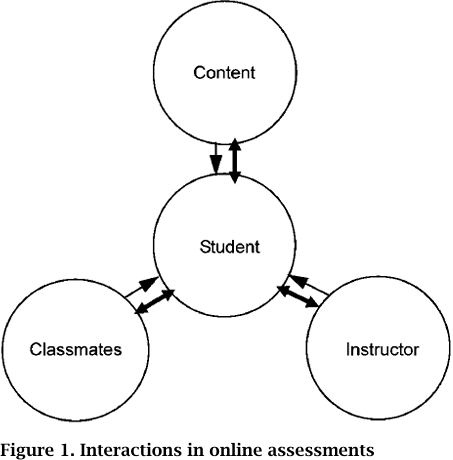
Enrichment of Interaction in Online Assessments Paul Lam & Paula Hodgson & Josephine Csete
 المؤلف:
Paul Lam & Paula Hodgson & Josephine Csete
المؤلف:
Paul Lam & Paula Hodgson & Josephine Csete
 المصدر:
Enhancing Teaching and Learning through Assessment
المصدر:
Enhancing Teaching and Learning through Assessment
 الجزء والصفحة:
P392-C33
الجزء والصفحة:
P392-C33
 2025-08-09
2025-08-09
 280
280
Enrichment of Interaction in Online Assessments
Learning occurs when learners impart meanings and structures to knowledge and information (Taylor and Maor, 2000). Learning is thus thought to be enhanced by engaging students in an interactive learning environment, as feedback and reflection effectively help knowledge construction (O'Connor, 1998).
The engagement of learners in a learning environment of this kind is a key reason for bringing learning technologies into teaching (Baldwin et al., 2000). Learners are thought to be active conceptualizers. They need to be actively engaged and to develop skills in analysis, synthesis and evaluation as part of their course requirements (Institute for Higher Education Policy, 2000). They can manipulate and organize resources while interacting in the inquiry tasks (Grabe, M. and Grabe, C., 2004). They can then synthesize, evaluate and reflect on how they develop skills, knowledge and values in their subject areas.
In contrast to conventional paper-based assessment, more interaction is likely to occur in online assessment. This is particularly true when online assessment is used as a formative evaluation tool, and it contributes to learning by providing feedback relating to performance. In general, it can be said that the contribution to learning provided by assessment will be enhanced by better learner engagement through improving the interactivity of the assessment.
Interaction comes in many different forms. Swan (2003) explains interaction as "the reciprocal events involving at least two actors and/or objects and at least two actions in which the actors, objects, and events mutually influence each other" (p.4). She sees e-learning as being able to facilitate at least three main kinds of learning-enhancing interaction: interaction with content, with instructors and with peers.
We employ Swan's model (drawn from Moore (1989)) to investigate the interactivity in online assessments. Figure 1 illustrates how, under the model, a student can act on and obtain responses in all three areas: content, peers and instructors.

Online assessments, for the purpose of this study, may employ either a formative or summative function. Here are some examples of online assessment:
1. Content: online quizzes and exercises can be used for students to assess their understanding of content materials. Students may be allowed multiple attempts to interact with quizzes in a question bank or clarify misunderstandings though feedback on incorrect answers.
2. Peers: forums can be provided for students to take part in discussions on assigned topics. Individual or group contributions to the forum can be assessed quantitatively and/or qualitatively.
3. Instructors: the online submission of assignments can allow both learners and instructors to discuss areas for improvement before the final submission and grading.a
 الاكثر قراءة في Teaching Strategies
الاكثر قراءة في Teaching Strategies
 اخر الاخبار
اخر الاخبار
اخبار العتبة العباسية المقدسة


